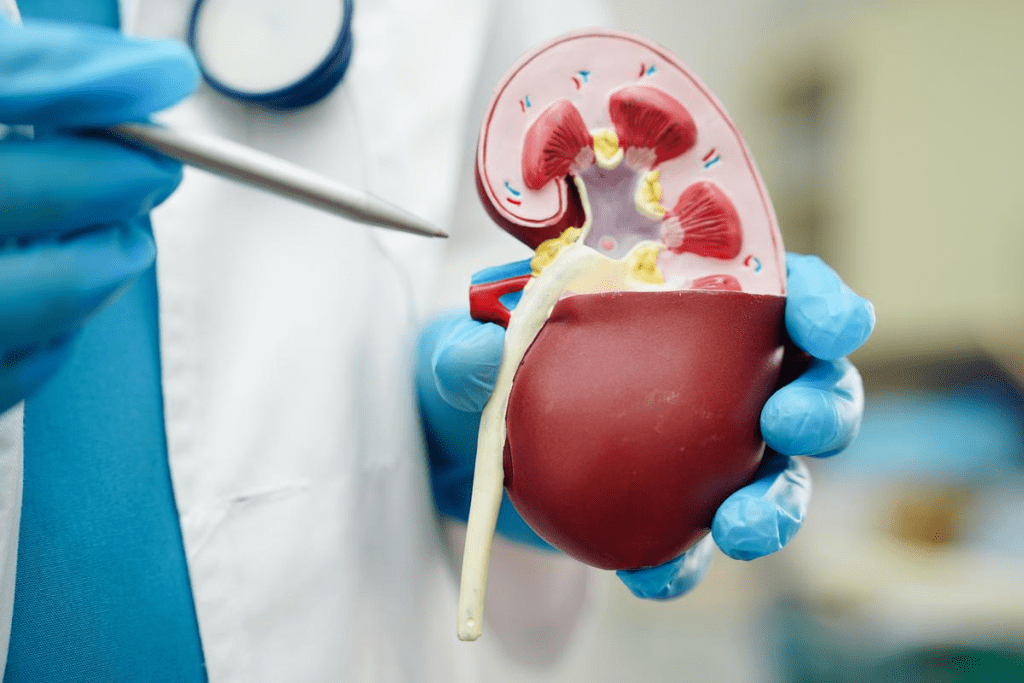Last Updated on November 25, 2025 by
Extracorporeal Shock Wave Lithotripsy (ESWL) is a common, non-invasive way to treat kidney stones. But research shows it might harm your kidneys. This is a concern for many.

Using lithotripsy for kidney stones can lead to serious problems. These include sudden kidney damage and long-term issues like high blood pressure and diabetes. It’s important for both patients and doctors to know about these risks.
Extracorporeal Shock Wave Lithotripsy (ESWL) is a non-invasive treatment. It uses high-energy acoustic pulses to break down kidney stones. This makes it easier for the body to pass them out.
This method is very effective. It also has a shorter recovery time compared to old surgical methods.
The ESWL procedure creates high-energy shock waves outside the body. These waves are then focused on the kidney stone. This is why it’s called “extracorporeal.”
A machine called a lithotripter makes these shock waves. When the waves hit the stone, they break it into smaller pieces. This is called fragmentation.
The process works by creating forces on the stone. The shock wave compresses it and then reflects off the back. This combination breaks the stone into smaller pieces.

ESWL became popular because it’s non-invasive. It doesn’t need surgical cuts. This reduces the risk of complications and speeds up recovery.
The procedure is effective without the need for anesthesia or a long hospital stay. This made it appealing to both patients and doctors.
Some key benefits of ESWL include:
These advantages have made ESWL a widely accepted treatment for kidney stones.
Extracorporeal shock wave lithotripsy (ESWL) is a non-invasive method for treating kidney stones. Yet, it can cause immediate damage to the kidneys. This damage is a concern for many.

Shock waves from ESWL can harm the kidney tissue. This damage can cause inflammation and bruising. It may even lead to acute kidney injury.
The extent of the damage depends on the shock wave intensity and frequency. More intense and frequent treatments increase the risk of kidney injury.
Subcapsular hematomas are another risk with ESWL. These are blood collections between the kidney and its capsule. Up to 13% of patients may develop them.
These hematomas can cause pain, inflammation, and long-term kidney damage. In some cases, they may need medical treatment to avoid further issues.
In summary, ESWL is effective for kidney stones but comes with risks. Knowing about the possible damage to the kidneys is key to choosing the right treatment.
Research shows that ESWL patients face a higher risk of hypertension. Many studies have found this link, showing the need to think about ESWL’s long-term effects.
People who have had ESWL are 30-50% more likely to get hypertension. This big increase in risk makes it key to watch blood pressure after ESWL.
A study in a top medical journal said, “The rise in hypertension after ESWL is a big worry. We need to watch closely and maybe take steps to prevent it.”
“The long-term effects of ESWL on blood pressure regulation are not entirely understood and require further investigation.”
ESWL’s shock waves can harm blood vessels, affecting the kidneys’ blood pressure control. This harm can cause blood pressure to stay high, leading to hypertension.

The damage to blood vessels from ESWL disrupts blood pressure control. So, patients should be watched for signs of high blood pressure after ESWL.
The link between ESWL and diabetes is a key area for medical research. As lithotripsy for kidney stones becomes more common, it’s important to understand its health effects.
ESWL shock waves aim at kidney stones but can affect nearby tissues, like the pancreas. This has raised health concerns. Research shows these shock waves might harm the pancreas, affecting insulin and blood sugar levels.
Key findings include:
Many clinical studies have looked into ESWL’s link to diabetes. These studies offer insights into the metabolic effects of lithotripsy for kidney stones.
Notable research includes:
In summary, while lithotripsy is effective for kidney stones, its diabetes link to diabetes needs further study. Patients and doctors should consider this when deciding on ESWL treatment.
Having to go through multiple lithotripsy treatments can harm your kidneys. This is more likely with bigger kidney stones. These stones need more than one extracorporeal shock wave lithotripsy (ESWL) to break down completely.
Bigger kidney stones are harder to treat with lithotripsy, a medical term. Their size and where they are in the kidney might mean you need more blasting kidney stone sessions. A top urologist says, “The bigger the stone, the more likely you’ll need to do it again.”
“The larger the stone, the higher the likelihood of requiring repeat treatments.”
Each kidney stone lithotripsy treatment can hurt your kidneys. Doing it more than once increases this risk. It could lead to lasting kidney problems. Research shows that many ESWL sessions can seriously damage your kidneys.
If you’re having to do lithotripsy more than once, watch out for signs of kidney damage. Doctors are always looking at how safe ESWL is, but it’s a big worry for those needing many treatments.
Extracorporeal shock wave lithotripsy (ESWL) is a treatment for kidney stones. It uses shock waves to break stones into smaller pieces. This makes it easier for the body to pass them out.
But ESWL can cause long-term kidney damage. It can lead to a decrease in kidney function. This is because it damages the nephrons, which are key to filtering waste.
The shock waves from ESWL can harm the kidneys. They cause inflammation and scarring. This damage affects the nephrons.
The damage to nephrons is complex. It involves harm to the blood vessels in the kidneys. This reduces blood flow to the area.
ESWL can significantly reduce kidney function volume. This can be seen with imaging like CT scans or MRI.
A study in the Journal of Urology found a big difference. Patients who had ESWL had less kidney function than those who didn’t.
This reduction in kidney function is a worry for patients. It’s important to talk about the risks and benefits with a healthcare provider. This helps patients make the best choice for their trseatment.
New ways to deliver shock waves in ESWL are showing great promise. Studies are looking into how to send shock waves during the ESWL procedure to lessen kidney harm.
Scientists are trying new methods to lessen kidney damage from shock waves. One method is stepwise voltage ramping, which has been shown to lower kidney injury rates. Also, low-frequency shock waves are proving to be more effective and gentler than the old high-frequency waves.
Improving how we choose patients for ESWL is also key. By picking the right patients based on stone size, location, and kidney health, doctors can lower ESWL risks. Advanced imaging techniques help make these choices more accurate, leading to better results.
These new steps are vital for making ESWL safer and more effective for kidney stone patients. By keeping up with these innovations, doctors can lower the chance of kidney damage and improve patient outcomes.
Patients need to understand what lithotripsy for kidney stones means. This treatment, known as Extracorporeal Shock Wave Lithotripsy (ESWL), is common. But, it’s key to know its possible risks and side effects.
Knowing about lithotripsy and its impact on kidney health is vital. Patients should be aware of the risks. These include damage to the kidneys, higher blood pressure, and diabetes.
When thinking about lithotripsy, weighing its benefits and risks is important. Patients should talk to their doctor about their situation. This way, they can choose the best treatment for their needs.
ESWL is a non-invasive treatment for kidney stones. It breaks stones into smaller pieces. These pieces can then be easily passed out of the body.
ESWL uses shock waves to break kidney stones. These shock waves are delivered from outside the body. They focus on the stone, causing it to break apart.
ESWL can cause acute kidney damage. It may also increase the risk of hypertension and diabetes. Repeated treatments can lead to more damage over time.
Yes, ESWL can cause permanent damage to the kidneys. It can destroy nephrons, leading to a permanent loss of kidney function.
Yes, new technologies and protocols have been developed. They aim to reduce the risk of kidney damage during ESWL treatments.
Studies suggest ESWL may increase the risk of hypertension. This could be due to vascular damage from the shock waves, affecting blood pressure.
Some studies suggest a link between ESWL and diabetes. This might be due to shock waves affecting the pancreas.
Larger stones often need more than one ESWL treatment. A single session may not break the stone into small enough pieces.
Multiple ESWL sessions can cause cumulative damage. This increases the risk of long-term kidney problems, including permanent damage.
Patients should understand the risks and benefits of ESWL. This includes its impact on kidney health. This knowledge helps them make informed treatment choices.
Ahmed, K., Ramsay, H., Royle, J., Dobbs, R., & Vale, J. (2006). The Acute and Long-Term Adverse Effects of Shock Wave Lithotripsy. PMC.This review discusses both immediate tissue trauma and potential chronic adverse effects such as hypertension and renal injury.https://www.ncbi.nlm.nih.gov/pmc/articles/PMC2900184/
Jurkovic, J., Bubic, M., & Modrzejewski, A. (2023). Extracorporeal shockwave lithotripsy“induced renal blunt trauma: a prospective observational study. Urology Case Reports / ScienceDirect.Documents incidence of hematoma, hematuria, and subclinical renal injury following ESWL.https://www.sciencedirect.m/science/article/pii/S2214442023002784
Subscribe to our e-newsletter to stay informed about the latest innovations in the world of health and exclusive offers!